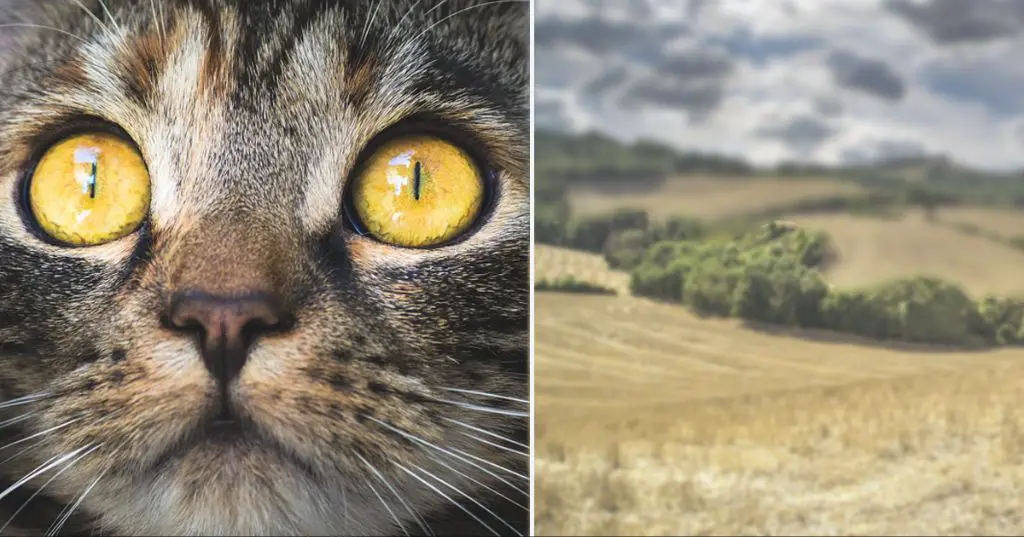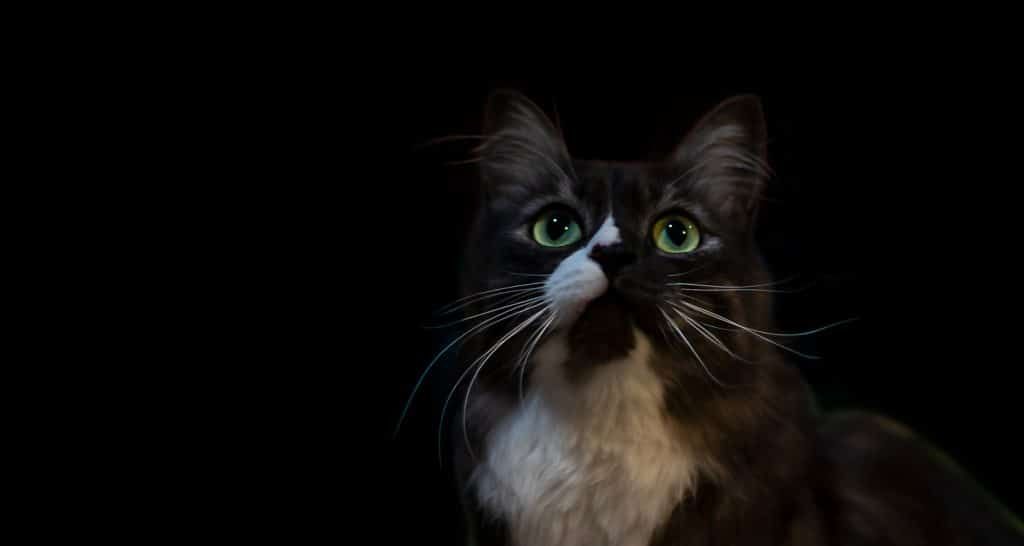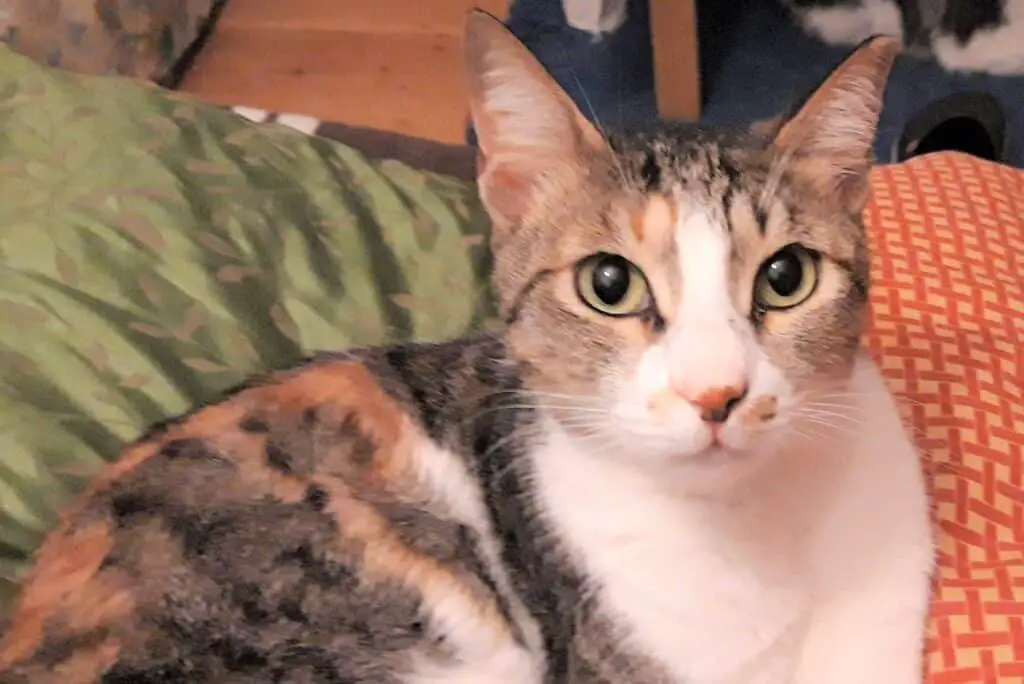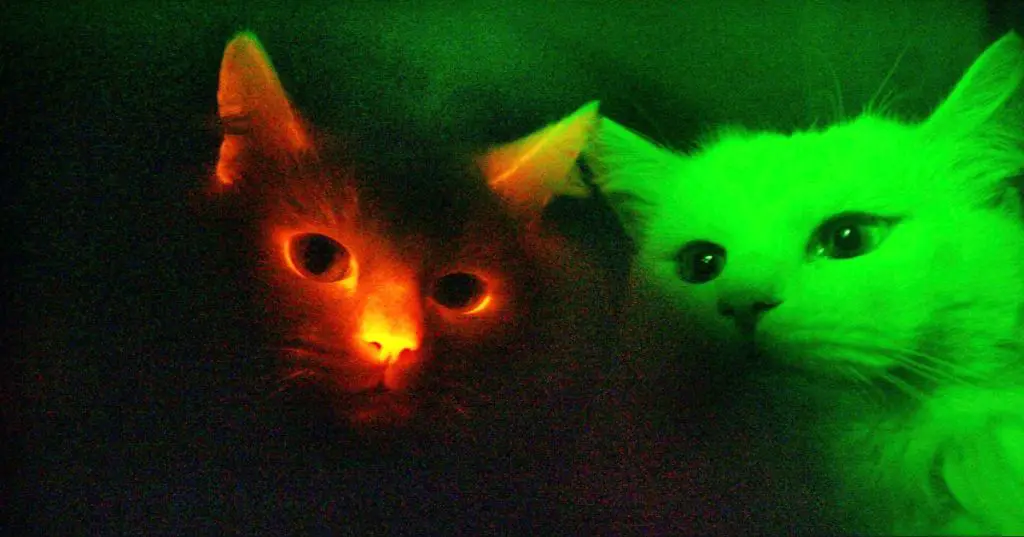A cat’s vision differs in some significant ways from human vision. While humans are visual hunters that excel at seeing detail and color during the day, cats are effective nocturnal hunters that excel at detecting motion at night (Source).
Cats have a wider field of view, superior night vision, and see some ultraviolet light. However, they do not see color as vividly as humans and can’t focus well on objects close to their faces. A cat’s world appears more blurry and dimmer than a human’s, but with enhanced sensitivity to movement.
While vision is important, a cat’s sense of smell plays a huge role in how they experience their environment. Their superior sense of smell helps them effectively hunt prey even when it’s hard for them to spot it visually.
Cats Have Superior Night Vision

Cats can see much better in low light conditions compared to humans. Their eyes have a high density of rod cells, which are more sensitive to light than cone cells. Rod cells allow cats to see in very dim light. Cats also have a structure called the tapetum lucidum, which is a reflective layer behind the retina. It acts like a mirror to reflect light back through the retina, allowing light to stimulate rod cells twice. This allows cats to make the most of any available light (1). The tapetum lucidum is what causes cats’ eyes to seem to glow at night when light shines into them.
Studies have shown cats can see up to 6 times better than humans in low light because their eyes are so adept at amplifying minimal light sources. So while cats can’t see perfectly in complete darkness, their vision is superior to ours under low light conditions like dusk, dawn, or nighttime (2). This allows cats to effectively hunt prey and navigate their territory even in darkness.
Sources:
(1) https://www.hillspet.com/cat-care/behavior-appearance/can-cats-see-in-the-dark
(2) https://www.purina.co.uk/articles/cats/behaviour/common-questions/can-cats-see-in-the-dark
Wide Field of View

Cats have a significantly wider field of view compared to humans. While humans see about 180 degrees around them, cats can see almost 300 degrees around them. This gives cats a much wider scope of vision and allows them to better detect motion and potential threats approaching from the sides or behind them. According to research on Reddit, a cat’s field of view is around 200 degrees, which is 20 degrees wider than a human’s field of view. Their eyes are positioned more toward the sides of their heads, giving them a panoramic view of their surroundings.
Seeing Color
Cats do see color, but their perception of colors is more muted compared to humans. While humans have three types of color receptors (called cones) in their eyes that allow us to see the full range of colors, cats only have two types of cones According to VCA Animal Hospitals. This means cats can’t distinguish between as many shades and hues. Instead of seeing the full spectrum, cats are believed to mainly see various shades of blue, greenish-blue, gray, and yellow The Wildest reports.
While we see vibrant, saturated colors, cats have a more pastel vision of the world. Their color perception is similar to a human who is color blind. So when cats look at an object, they don’t see all the details and color variations that human eyes pick up. Their vision focuses more on motion and brightness rather than color.
Cats Can’t Focus Up Close

One of the key differences between cat and human vision is that cats are farsighted. Their eyes are adapted to focus on distant objects very clearly, but have difficulty focusing on things that are up close.1 This is why cats may appear cross-eyed or squint when looking at objects close to their face.
A cat’s eyes can form a sharp image of objects that are about 25 cm away. But anything closer than that will look blurry to them. Cats simply lack the ability to accommodate their eyes to focus that near.2 This is actually an adaptation to support their hunting skills. Cats are able to spot prey from far away and judge distances accurately. But they don’t need to focus at extremely close ranges.
Sensitive to Motion
Cats have excellent motion detection due to the high number of rod cells in their eyes. Rod cells allow cats to see movement and track prey in low light conditions. As nocturnal hunters, cats rely on their superior night vision and motion detection to locate and catch food. While humans have about 120 million rod cells, cats have about 250 million, giving them heightened sensitivity to movement.
This allows cats to easily notice even the slightest motion of a leaf or insect. Their wide field of view and ability to detect fast movement makes cats adept hunters. Even when relaxing, a cat’s ears may twitch at sounds too faint for human ears. Their heads turn in response to movements imperceptible to us. This sensitivity comes from the high concentration of rod cells evolved for dim light hunting.
Cats’ motion detection abilities are why they can set off security alarms designed for humans. Special pet-immune motion detectors are required in homes with cats. These detect the unique heat signature of humans while ignoring pets. For cats owners, investing in pet-friendly motion sensors helps avoid false alarms triggered by a curious cat on the prowl.
Cats Have a Nictitating Membrane for Eye Protection
Cats have an additional eyelid called a nictitating membrane or third eyelid located in the inner corner of their eyes. This translucent eyelid moves horizontally across the eye to protect and moisturize it (“Why do cats have an inner eyelid as well as outer ones?”, 2006).
The third eyelid helps shield the large exposed cornea of cats’ eyes from damage when hunting prey, fighting with other cats, or exploring their environment (“The Anatomy and Function of a Cat’s Third Eyelid”, 2021). It spreads tears across the surface of the eye and can dislodge debris or foreign objects. The nictitating membrane also provides lubrication when cats are sleepy or unwell and not blinking regularly.
See Some UV Light
Cats can see ultraviolet light to some degree, unlike humans who cannot see UV light at all. Specifically, cats can see wavelengths from 300 nm down to about 270 nm in the UV spectrum. This allows cats to detect UV markings and patterns on flowers and other objects that are not visible to human eyes.

Researchers have discovered that cats, along with dogs and other mammals, have a type of retina cell that is sensitive to UV light due to a light-sensitive protein they contain. This protein allows UV wavelengths to be detected and processed into feline color vision [1].
Seeing parts of the UV spectrum may help cats with navigation, communication, hunting, and other natural behaviors. Cat owners sometimes use UV flashlights or cat toys with UV reactive properties to provide extra enrichment.
[1] Color My World: Cats and Dogs May See in Ultraviolet
Scent is Also Important
In addition to their exceptional vision, cats also rely heavily on their sense of smell for hunting (Cat Senses). A cat’s sense of smell is 14 times better than humans. They have 200 million odor-sensitive cells compared to only 5 million in humans (Cat Senses: This Is How Cats Experience the World).
Cats use scent to identify other cats, people, and places. Their superior sense of smell allows them to locate prey even when it’s hiding or camouflaged. They can detect scents over long distances carried by air currents. A cat’s scent glands and facial rubbing behaviors also help spread their own scent to mark territory and communicate with other cats.
So while a cat’s vision is exceptional, their sense of smell complements it perfectly for hunting. They rely on both vision and scent together to effectively locate and catch prey.
Conclusion
In summary, cat vision differs from human vision in several key ways. Cats have superior night vision due to having a higher density of rods in their eyes. They also have a wider field of view of about 200 degrees compared to humans’ 180 degrees. While humans see color better, cats can still differentiate between blues and greens. One of the biggest differences is that cats struggle to focus on objects close-up, whereas humans can see near and far. Cats are also more sensitive to motion due to having more rod cells. Additionally, they have a third eyelid called a nictitating membrane that protects their eyes. One unique aspect of cats is their ability to see some ultraviolet light that humans cannot. While vision is important to cats, scent plays a key role in how they experience the world as well.
In the end, cats and humans have evolved different visual systems to suit their needs. Cats have specialized night hunting vision, while human vision prioritizes detail and color. Yet both allow each species to thrive in their environments.

